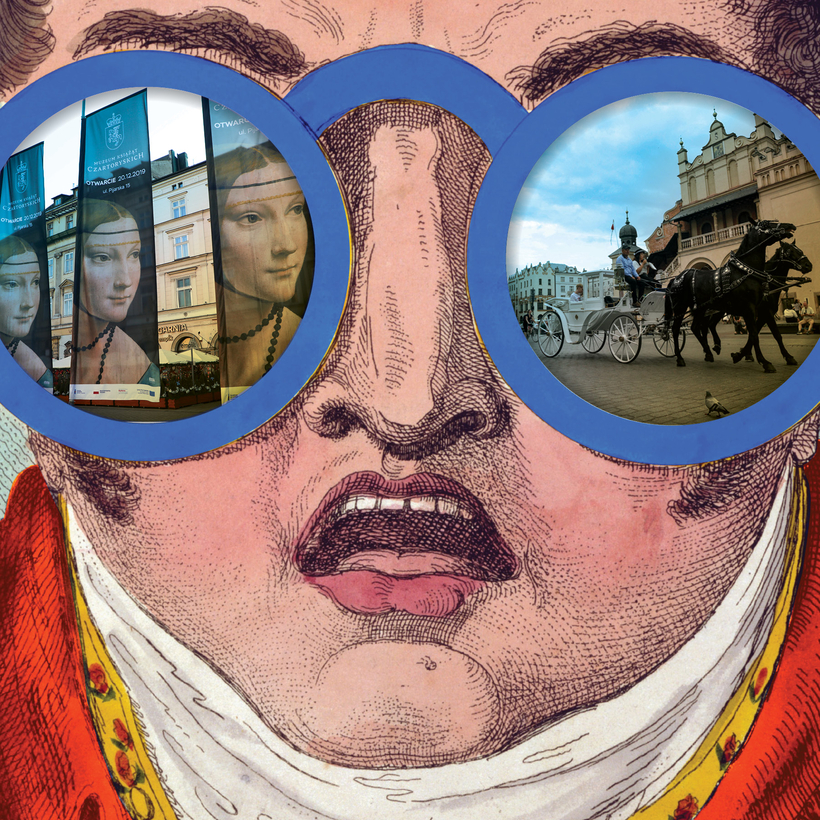On a recent Friday, I sought out one of the most revered masterpieces in Western art. Leonardo da Vinci’s Lady with an Ermine is a Renaissance portrait of Cecilia Gallerani, the mistress of the Duke of Milan; it rests inside a former palace, now the Czartoryski Museum, in Kraków, Poland.
Believed to have been painted around 1490, it depicts a demure young woman draped in black glass beads, cradling a snow-white ermine. She wears an inscrutable expression that da Vinci would perfect a decade later in the Mona Lisa.
As I stood a few feet away, gazing at the woman’s long, thin fingers, it was hard not to notice that I was the only person in the room—and one of just a few in the museum. While a private viewing of one of Western civilization’s treasures was a rare thrill, it was also a moment that mirrored the current hollowness in one of the world’s staggeringly lovely cities—one whose entire, quintessentially European, center is a UNESCO World Heritage Site.
Kraków, 160 miles from the border of Ukraine, is reeling from a precipitous drop in tourism—a crisis, largely, of perception.
Since Putin’s invasion of Ukraine, on February 24, an estimated 3.5 million people have fled to safety in Poland, and from there have dispersed both throughout the country and the rest of Europe.
Early on, images of incalculable human tragedy flooded our newsfeeds. Throngs of refugees, 94 percent of whom were women and children, had escaped Russian bombardments and huddled at Kraków’s central train station, or crammed into World Central Kitchen’s local outpost.
Since then, Poland has done an extraordinary job of assimilating Ukrainians, if they wish to stay in the country. According to Notes from Poland, a network of English-language media, the country has issued almost one million PESELs—identity cards that entitle the bearer to state benefits such as school and health care.
But foreign tourists are spooked. “We can’t tell anyone what they should be afraid of,” says Izabela Czuchra, of SeeKraków, a tour outfitter in town. The numbers are mind-boggling: As of late May, an average 10 clients per day, compared with 800 to 1,000 per day before the pandemic. From a pinnacle of 14 million visitors in 2019, the numbers have dropped to a fraction of that.
In 2020, people postponed their bookings when the coronavirus shut down the country, but when the war in Ukraine started, they canceled them altogether. “The tourism sector is trying to communicate the message that it is safe here, which it absolutely is,” Grzegorz Biedroń, chairman of Lesser Poland Tourist Organization (Kraków’s province), who notes that the actual conflict is raging hundreds of miles from the Polish border. “But for some reason it does not sound credible.”
This year, embers of the Soviet empire, which Poland cast off in 1990, ignited again, as Moscow spread destruction and human calamity across the borders of Europe. I landed in Kraków anticipating a war zone but instead experienced the opposite. Spring light spilled over the city’s intact Baroque, medieval, and Renaissance buildings and on the ancient streets of Old Town. New green grass and swaths of daffodils grew with abandon among Jagiellonian University’s brick campus, where Nicolaus Copernicus began formulating the heliocentric model of the universe, and where Karol Wojtyla, the future Pope John Paul II, earned his graduate degrees in theology and taught philosophy. Bells pealed from the ancient spires of Wawel Cathedral, across the cobblestones of Rynek Glówny and along the banks of the Vistula River.
“The tourism sector is trying to communicate the message that it is safe here, which it absolutely is.”
Yes, a small group of Ukrainians gathered in the main square each day to sing patriotic songs, raising NATO, OPEN THE SKY placards. I saw young Ukrainian mothers with strollers lined up for support and supplies at the Jewish Community Center in Kazimierz, the solemnly-preserved neighborhood were many residents were forced into the Krakow ghetto and killed during Nazi occupation. And inside the central train station, refugees slept on mattresses before departing for Warsaw, Berlin, or Prague.
Since the Russian invasion, the city’s population has increased by 23 percent, as authorities try to assist with jobs and housing—some in tourist-starved hotels—for their war-ravaged neighbors. But when I sat outdoors at Café Noworolski, drinking hot chocolate thicker than yogurt, I saw not refugees but emptiness. Over several days, I met tour guides, waiters, and hotel workers with one message: Please come to Kraków.
Many travelers assume (as I did) that the war is spilling onto Kraków’s gilded streets. It is a frustration for Marcin Ziobro, the elegant general manager of H15 Luxury Palace. Among the newest of Kraków’s 16 five-star hotels, it is an achingly glamorous sanctuary in the former Lubomirski Palace. “People are afraid to come here, since we share a border with Ukraine,” he says. “But we are part of NATO and covered by that great safety umbrella.”
The rooms at H15 are embellished with centuries-old ceiling frescoes, lush linen curtains, and the kind of freshened-up antiques that feel sleek rather than dated. And at the end of Easter week, during what should be peak luxury-tourism season, they remained partially unoccupied. “I would like people to know that Kraków is secure,” he says.
At another luxury hotel, the Bonerowski Palace, I sat with general manager Blazej Tolwinski over grilled sea bass, fire-roasted potatoes, and cheesecake sourced from Tatra Mountain dairy cows. From the table, we looked onto Rynek Glówny, where empty horse carriages lined up under the 14th-century Gothic spires of St. Mary’s Basilica. Tolwinski tells me about the recent cascade of cancellations. “I’m trying to be very flexible,” he says, “and to understand that it is not possible for anyone to know how safe it is until you are here.”
Earlier, he walked me through the hotel, parts of which date to the 13th century. The center of the winding staircase is pierced by a 70-foot crystal chandelier, the longest in Europe. Several of the 16 rooms are richly rendered and full of soft recamiers; bunched, bold-colored draperies; and ethereal wall paintings, some from the 1600s. “My job is not to look at the numbers and cry,” he tells me. “My job is to think, What can we do differently so we can operate without worries?”
As Vladimir Putin grows even wilder and more unpredictable, and Poland shines in its crucial role in the ongoing humanitarian refugee crisis, Kraków’s tourism industry continues to suffer. It is hoped and anticipated that, with its lovely bones, incandescent light, and silk-wrapped hotel rooms, not to mention hospitality that it is now extended to its traumatized neighbors, Kraków will soon, again, be a draw for foreigners. Since Easter week, numbers have crept up slightly, but mostly, according to Ziobro, due to domestic visitors rather than the coveted international ones.
“We are very modern and tolerant, and open to the world,” says Grzegorz Biedroń. “Over the centuries, Kraków has survived a lot.” And, it is assumed, as long as the world survives Putin, it will survive this too.
Marcia DeSanctis is a contributing writer for Travel + Leisure and writes essays and stories for Vogue, Town & Country, Departures, and BBC Travel. Her new book, a collection of travel essays called A Hard Place to Leave: Stories from a Restless Life, is out now


